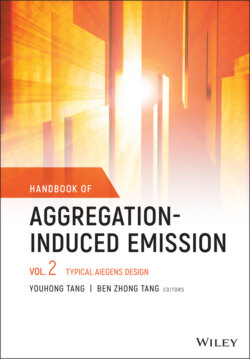Читать книгу Handbook of Aggregation-Induced Emission, Volume 2 - Группа авторов - Страница 18
1.3.1 Organic Light‐emitting Diodes
ОглавлениеTPP is electron‐deficient and shows emissions around 400 nm, which is helpful for designing blue emission materials by further structural decoration. When TPP is modified by the strong electron‐donating triphenylamine group, a derivative of TPP–TPA is obtained (Chart 1.2). TPP–TPA shows a twisted intramolecular charge transfer (TICT) effect in the polar solvents, while the AIE effect was activated in the aggregate state. The photoluminescence (PL) studies of TPP–TPA indicate that it emits at 455 nm at powder state with an absolute quantum yield (ΦF) of 35.2% recorded by the integrating sphere. Since the AIE materials are competent to act as luminescent materials to fabricate highly efficient nondoped OLEDs, it is thus very promising to utilize this material for blue OLED fabrication. A typical triple‐layer device with a configuration of ITO/NPB (60 nm)/TPP–TPA (20 nm)/TPBi (40 nm)/LiF (1 nm)/Al is designed, while ITO, NPB (N,N′‐di(1‐naphthyl)‐N,N′‐diphenyl‐benzidine), TPBI (1,3,5‐tri(1‐phenyl‐1H‐benzo[d]imidazol‐2‐yl)phenyl), LiF, and Al are used as anode, hole‐transporting layer, electron‐transporting layer, electron‐injecting layer, and cathode, respectively. The device emits at 482 nm with a turn‐on voltage (Von), a maximum luminescence (Lmax), and an external quantum efficiency (EQE) of 3.7 V, 17 459 cd/m2 and 2.88%, respectively (Table 1.1, Device I). Although a high‐lying highest occupied molecular orbital energy level (−5.04 eV) of TPP–TPA is evaluated by cyclic voltammetry, a simplified double‐layer device without the hole‐transporting layer (TPP–TPA is expected to act as both light‐emitting and hole‐transporting layers) does not show an improved device performance [50].
Chart 1.2 Molecular structures of TPP–TPA and TPP–PPI.
Table 1.1 EL performance of devices.
| λ EL (nm) | V on a (V) | Lmaxb (cd/m2) | ηCb (lm/W) | ηPb (lm/W) | EQEb (%) | CIE (x, y)b | |
|---|---|---|---|---|---|---|---|
| TPP–TPA (I) | 482 | 3.7 | 17 459 | 5.49 | 3.18 | 2.88 | — |
| TPP–TPA (II) | 472 | 2.8 | 19 170 | 6.57 | 6.55 | 4.08 | 0.15, 0.21 |
| TPP–PPI | 474c | 2.9 | 16 460 | 8.34 | 8.18 | 4.85 | 0.16, 0.23c |
a V on = turn‐on voltage at 1 cd/m2.
b The maximum luminescence (Lmax), current efficiency (ηC), power efficiency (ηP), and external quantum efficiency at the maximum values for the devices.
c Data recorded at a luminescence of 1000 cd/m2.
It was later reported that TPP derivatives with a D–A structure possess a planarized intramolecular charge transfer (PLICT) effect in the excited state in the polar media. For example, the ΦF of TPP–TPA in toluene, ethyl acetate, dichloromethane, and DMF changes from 22.7, 50.9, 80.7 to 80.9% as the polarity of the solvent increases. It is due to the formation of planarization conformation or quinone conformation with a good conjugation in the excited state to increase the probability of transition. In that work, another TPP–TPA‐based blue OLED (configuration: ITO/HATCN (5 nm)/TAPC (40 nm)/TCTA (5 nm)/TPP–TPA (20 nm)/Bepp2 (45 nm)/Liq (2 nm)/Al) is fabricated with HATCN (2,3,6,7,10,11‐hexacyano‐1,4,5,8,9,12‐hexaazatriphe‐nylene), TAPC (1,1‐bis(4‐di‐p‐tolylaminophenyl)cyclohexane), TCTA (4,4′,4′′‐tri‐9‐carbazolytriphenylamine), and Bepp2 (bis(2‐(2‐hydroxyphenyl)‐pyridine)beryllium) functioned as hole‐injecting layer, hole‐transporting layer, hole‐transporting and electron‐blocking layer, and electron‐transporting and hole‐blocking layer, respectively. However, a very good device performance with Von, Lmax, and EQE of 2.8 V, 19 170 cd/m2, and 4.08%, respectively, is obtained (Table 1.1, Device II) [51].
The PLICT effect also takes places in phenanthroimidazole derivative‐modified TPP (TPP–PPI), though the phenanthroimidazole‐based group is not so electron‐donating (Chart 1.2). TPP‐PPI shows the AIE effect in THF/water mixtures and emits at 470 nm in the film with ΦF of 28.1%. While fabricating it into the device with a configuration of ITO/HATCN (5 nm)/NPB (40 nm)/TcTa (5 nm)/TPP–PPI (20 nm)/TPBi (40 nm)/LiF (1 nm)/Al, an excellent device performance of Von (2.9 V), Lmax (16 460 cd/m2), and EQE (4.85%) is achieved. It is worth noting that the theoretical limit of EQE of OLEDs fabricated with typical fluorescent materials is 5%. Thus, it demonstrates the huge potential of developing OLEDs with TPP‐based luminescent materials [52].
